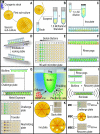High-throughput metal susceptibility testing of microbial biofilms
- PMID: 16202124
- PMCID: PMC1262724
- DOI: 10.1186/1471-2180-5-53
High-throughput metal susceptibility testing of microbial biofilms
Abstract
Background: Microbial biofilms exist all over the natural world, a distribution that is paralleled by metal cations and oxyanions. Despite this reality, very few studies have examined how biofilms withstand exposure to these toxic compounds. This article describes a batch culture technique for biofilm and planktonic cell metal susceptibility testing using the MBEC assay. This device is compatible with standard 96-well microtiter plate technology. As part of this method, a two part, metal specific neutralization protocol is summarized. This procedure minimizes residual biological toxicity arising from the carry-over of metals from challenge to recovery media. Neutralization consists of treating cultures with a chemical compound known to react with or to chelate the metal. Treated cultures are plated onto rich agar to allow metal complexes to diffuse into the recovery medium while bacteria remain on top to recover. Two difficulties associated with metal susceptibility testing were the focus of two applications of this technique. First, assays were calibrated to allow comparisons of the susceptibility of different organisms to metals. Second, the effects of exposure time and growth medium composition on the susceptibility of E. coli JM109 biofilms to metals were investigated.
Results: This high-throughput method generated 96-statistically equivalent biofilms in a single device and thus allowed for comparative and combinatorial experiments of media, microbial strains, exposure times and metals. By adjusting growth conditions, it was possible to examine biofilms of different microorganisms that had similar cell densities. In one example, Pseudomonas aeruginosa ATCC 27853 was up to 80 times more resistant to heavy metalloid oxyanions than Escherichia coli TG1. Further, biofilms were up to 133 times more tolerant to tellurite (TeO3(2-)) than corresponding planktonic cultures. Regardless of the growth medium, the tolerance of biofilm and planktonic cell E. coli JM109 to metals was time-dependent.
Conclusion: This method results in accurate, easily reproducible comparisons between the susceptibility of planktonic cells and biofilms to metals. Further, it was possible to make direct comparisons of the ability of different microbial strains to withstand metal toxicity. The data presented here also indicate that exposure time is an important variable in metal susceptibility testing of bacteria.
Figures


Similar articles
-
Biofilm susceptibility to metal toxicity.Environ Microbiol. 2004 Dec;6(12):1220-7. doi: 10.1111/j.1462-2920.2004.00656.x. Environ Microbiol. 2004. PMID: 15560820
-
Persister cells, the biofilm matrix and tolerance to metal cations in biofilm and planktonic Pseudomonas aeruginosa.Environ Microbiol. 2005 Jul;7(7):981-94. doi: 10.1111/j.1462-2920.2005.00777.x. Environ Microbiol. 2005. PMID: 15946294
-
Persister cells mediate tolerance to metal oxyanions in Escherichia coli.Microbiology (Reading). 2005 Oct;151(Pt 10):3181-3195. doi: 10.1099/mic.0.27794-0. Microbiology (Reading). 2005. PMID: 16207903
-
Detection of Biofilm in Wounds as an Early Indicator for Risk for Tissue Infection and Wound Chronicity.Ann Plast Surg. 2016 Jan;76(1):127-31. doi: 10.1097/SAP.0000000000000440. Ann Plast Surg. 2016. PMID: 25774966 Review.
-
Standard versus biofilm antimicrobial susceptibility testing to guide antibiotic therapy in cystic fibrosis.Cochrane Database Syst Rev. 2020 Jun 10;6(6):CD009528. doi: 10.1002/14651858.CD009528.pub5. Cochrane Database Syst Rev. 2020. PMID: 32520436 Free PMC article.
Cited by
-
Microtiter susceptibility testing of microbes growing on peg lids: a miniaturized biofilm model for high-throughput screening.Nat Protoc. 2010 Jul;5(7):1236-54. doi: 10.1038/nprot.2010.71. Epub 2010 Jun 10. Nat Protoc. 2010. PMID: 20595953
-
Spatial distributions of Pseudomonas fluorescens colony variants in mixed-culture biofilms.BMC Microbiol. 2013 Jul 28;13:175. doi: 10.1186/1471-2180-13-175. BMC Microbiol. 2013. PMID: 23890016 Free PMC article.
-
Mineralogical variables that control the antibacterial effectiveness of a natural clay deposit.Environ Geochem Health. 2014 Aug;36(4):613-31. doi: 10.1007/s10653-013-9585-0. Epub 2013 Nov 21. Environ Geochem Health. 2014. PMID: 24258612
-
Potentiation of Tobramycin by Silver Nanoparticles against Pseudomonas aeruginosa Biofilms.Antimicrob Agents Chemother. 2017 Oct 24;61(11):e00415-17. doi: 10.1128/AAC.00415-17. Print 2017 Nov. Antimicrob Agents Chemother. 2017. PMID: 28848007 Free PMC article.
-
Nutrient transitions are a source of persisters in Escherichia coli biofilms.PLoS One. 2014 Mar 25;9(3):e93110. doi: 10.1371/journal.pone.0093110. eCollection 2014. PLoS One. 2014. PMID: 24667358 Free PMC article.
References
-
- Ceri H, Olson ME, Morck DW, Storey D, Read RR, Buret AG, Olson B. The MBEC assay system: Multiple equivalent biofilms for antibiotic and biocide susceptibility testing. Methods in Enzymology. 2001;337:377–384. - PubMed
Publication types
MeSH terms
Substances
LinkOut - more resources
Full Text Sources
Other Literature Sources
Molecular Biology Databases
Research Materials

